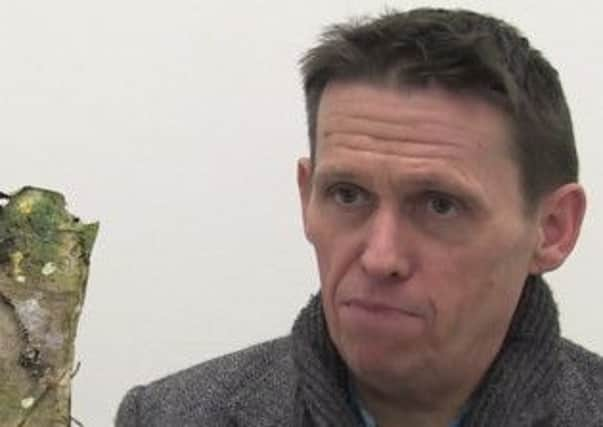Obituary: Ian Hughes, artist


THE untimely death of Ian Hughes has deprived Scotland of one of its most talented artists.
Born in Glasgow, Hughes attended Duncan of Jordanstone College of Art in Dundee, where his work showed early promise. As a student, he won a clutch of prizes, including a major travelling scholarship from the Scottish Education Department.
Advertisement
Hide AdAdvertisement
Hide AdEarly exhibitions at the 369 Gallery in Edinburgh and the RAAB Gallery and Fischer Fine Art in London confirmed the emergence of an artist with a powerful and passionate vision.
However, it was the 1987 show at the Scottish National Gallery of Modern Art, The Vigorous Imagination, which sealed Hughes’ reputation and opened up his work to an international audience. The exhibition, which focused on painting, included the work of artists from across Scotland and included Hughes’ friends and contemporaries such as Peter Howson, Ken Currie, Steven Campbell and Philip Braham.
The project’s curators included Keith Hartley from the National Galleries of Scotland and the critic Clare Henry, who has since championed Hughes work, in particular. The catalogue observed that “… Hughes is drawn to those states of mind and body which are abnormal, extreme and raw. They expose the underlying realities of life, which we tend to forget or gloss over in our busy everyday dealings…”
Following the success of The Vigorous Imagination, Hughes was invited to become Artist in Residence at SNGMA. An exhibition in 1989 at the same venue confirmed the choice as a judicious one, given the quality of work produced. This was self-portraiture at its most eviscerating, where the deepest realms of the psyche were opened to public scrutiny.
Writing at that time about the process of producing work Hughes commented: “Four Large Heads lying against the studio wall stared at me intently, accusing me of cowardice. I was feeling tired, ill, depressed. For eight long hours I had struggled with these works. Dragging myself up, I began to physically attack the images. I felt like a frenzied, wounded creature. I sacrificed my rational mind to the instincts of the animal, the madman, the psychopath.”
Public exposure did not sit easily with Hughes. He eschewed the trappings of success and continued to live and work as an artist dedicated to the pursuit of his personal vision. Increasingly this moved towards high empathy for those whom society had rejected, such as the homeless and the mentally ill. Hughes began to pursue a parallel career as a psychiatric nurse. Both vocations assumed equal importance and each nurtured the other.
It therefore seemed fitting that in 1991, in a direct combination of these roles, Hughes fulfilled a residency at the Royal Edinburgh Hospital, which specialises in the treatment of psychiatric illness.
It was around this that Hughes sustained serious facial injuries from a patient who attacked him with an metal oxygen bottle and which required him to undergo extensive maxillofacial surgery.
Advertisement
Hide AdAdvertisement
Hide AdThe link between his role as a medical professional and as an artist is key to understanding Hughes work. His work as a psychiatric nurse brought Hughes into contact with some of society’s most vulnerable and fragile human beings.
Hughes exhibited extensively in Europe where his work found a more receptive audience than in his home country. In 2005 Hughes’ empathic scrutiny reached a high point with an exhibition at the Phoenix 369 Gallery in Edinburgh. Testaments Betrayed was a series of portraits depicting the Twelve Disciples seen through a contemporary setting. Hughes’ working method was meticulous: he captured each ruptured blood vessel, the unkempt, nicotine-stained beards, the broken noses and the alcohol-ravaged skin of Peter, Thomas, Bartholomew, and Matthias.
Although Hughes held no structured Christian belief, he used imagery derived from Christ’s passion as a metaphor for the general suffering of humanity. Such an approach was evident in what turned out to be his final exhibition, held in Summerhall, Edinburgh, earlier this year.
Unearthed Tongues Set Free continued Hughes’ fascination with Poland and Russia as sites of historical humanitarian atrocity, as well as the legacy of continued human suffering. The passionate empathy of the works was partially fuelled by words such as those from Lamentations 3:52-53 “Mine enemies chased me sore like a bird without cause. They have cut off my life in the dungeon, and cast a stone upon me.”
The imagery, some borrowed from the religious tradition of the ikon, was harrowing and profound. Hughes spared neither himself nor the viewer. Photographs of Holocaust victims were overlayed and reworked, not superficially in the style of Andy Warhol, but with a suffused gravitas. Hughes drew comparisons with these historical atrocities, what he called “the inversion of morality,” with contemporary events, such as those in Syria.
Discussing his work, Hughes explained “I do believe words are very important, but at the end of the day I want people to come to this show and know nothing about me – even the titles don’t matter … I want them to look at the work and be moved by that … I want the art to reference people’s deeper sense of things, of morality and intellectual understanding…”
Ian Hughes is survived by his daughter Anna and his son Jacob.
GILES SUTHERLAND